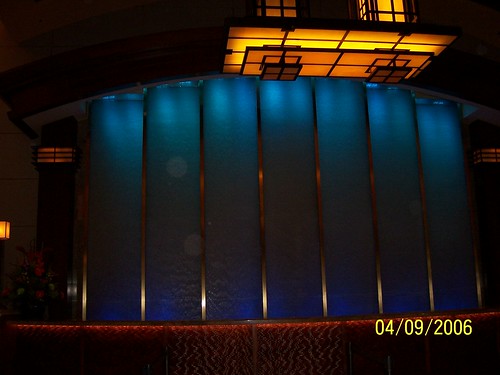Cache Creek is located in Brooks, about half an hour north of Sacramento. After exiting Highway 505, we wandered along a single-lane road through pastures and small towns. New housing developments signaled that we were approaching our destination. As we rounded the bend, a 200-room hotel and six-level parking garage in the midst of miles of farmland stood as testimony to the transformative economics of gambling.
We entered the hotel lobby and walked along the perimeter of the casino to the restaurants. Indian casinos are much stricter than Nevada establishments about allowing children in the gaming area. The security guard said that Cache Creek did not have activities, such as a bowling alley or videogame arcade, that could occupy the youngster. So much for my plans to spend a few hours at the tables.
The Harvest Buffet was extensive, above average by Vegas standards. The prime rib and sea bass were well prepared, not overdone yet very tender---a difficult accomplishment using heating trays and warming lights. We spent a couple of hours lingering over the food; two plates, plus dessert were my limit. Even if we had to pay the retail price, $67, for the four of us, it would have been worth it.
I was given an hour to try my luck. I stopped at the craps table and placed a bet on the pass line. The shooter rolled a three, “craps”—an immediate loser, but the croupier called out “seven”, a winner. I thought about making an appointment with my optometrist, but after a few more rolls where the dice clearly didn’t match the call, I stopped betting and looked around the table, trying to figure out what game we were playing.
Next to the croupier were two playing cards, placed face down. Each contained pictures of two die and represented a standard roll, for example, a 6-5 denoted an eleven and a 3-1, a four. Before each roll, the two cards were dealt face down from a special deck. The roll of the dice was only relevant insofar as it resulted in a “high” or “low” total, which signified which of the two cards to flip over. The card determined the number, not the die.
I played along for fifteen minutes and won a few dollars, but my suspicions grew. How did I know that the deck was true? Craps is a game of easily calculated probabilities; there are 36 possible combinations and all the payoffs are determined by the frequency of each combination. For example, there are six ways to roll a seven, and five ways to roll an eight. There are certain bets, such as the “odds” bet on the pass line, on which the casino pays true odds, i.e., it doesn’t take a percentage. A $5 odds bet wins $6 if an eight is rolled and loses $5 if a seven comes up, all other numbers in this case being irrelevant.
Although a roll of a seven wins immediately on the initial toss of the dice (a “front-line winner” on the “come-out roll”), craps players generally don’t like to see sevens because it causes them to lose most of their bets after the come-out roll. The purpose here, dear reader, is not to discuss the intricacies of the game but to point out that a deck stocked with sevens favors the house, and there was no way for me to verify that there were only six sevens in that special deck of presumably 36 cards. (Dice can be fixed, but for technical reasons, it’s more difficult and in any case can be prevented by changing the dice frequently.)
Back to the original question: how do we know the game is true? Government regulation wasn't apparent; the thick haze of cigarette smoke indicated that we weren’t protected by the laws of California. Content with a full stomach and slightly fuller wallet, I went home. © 2006 Stephen Yuen

No comments:
Post a Comment